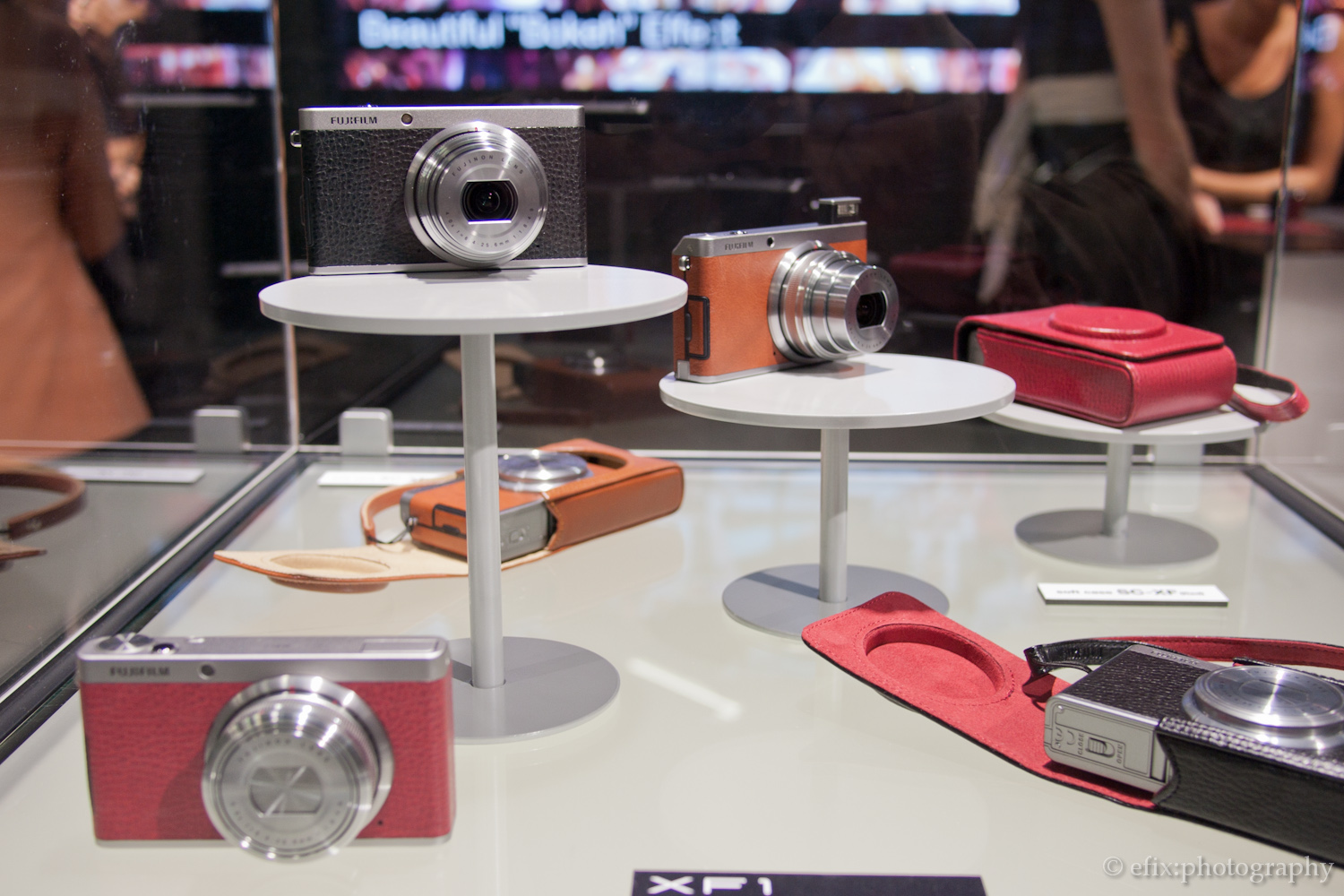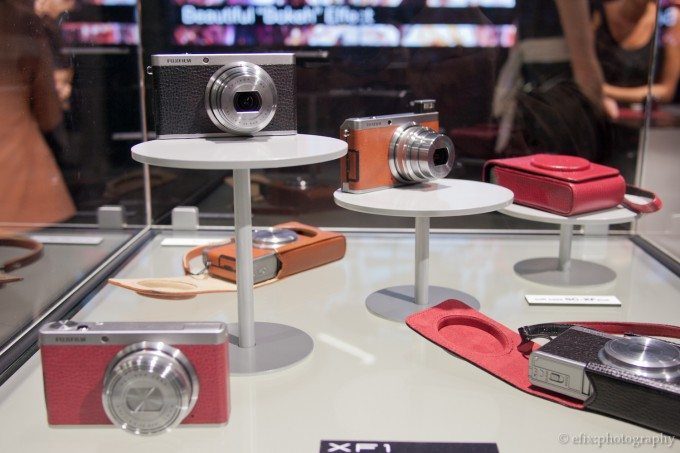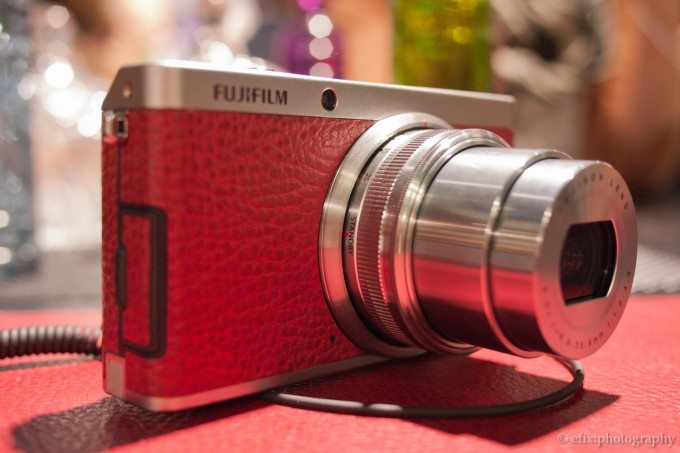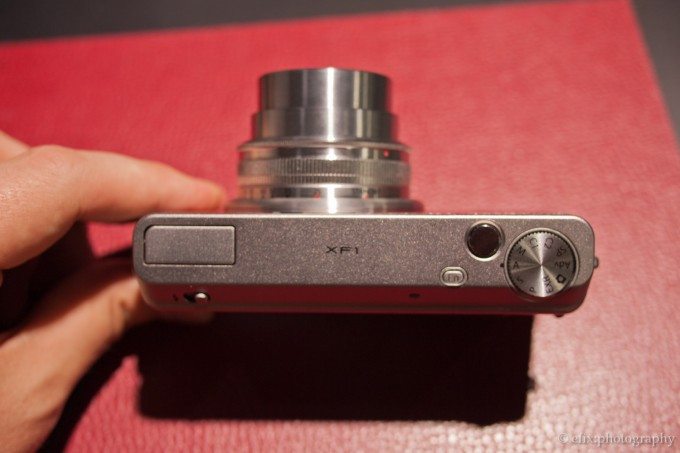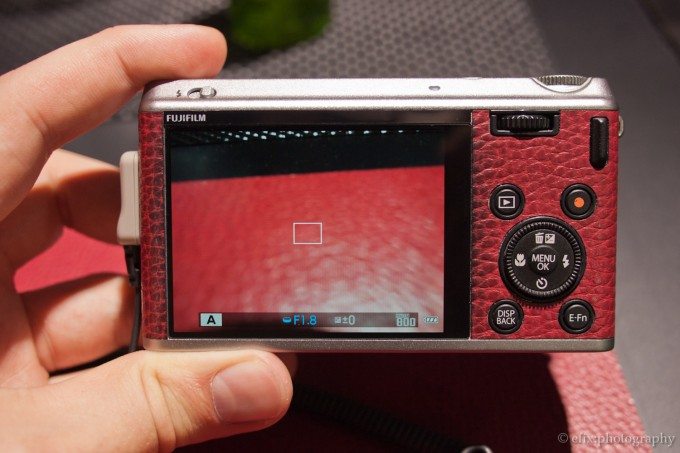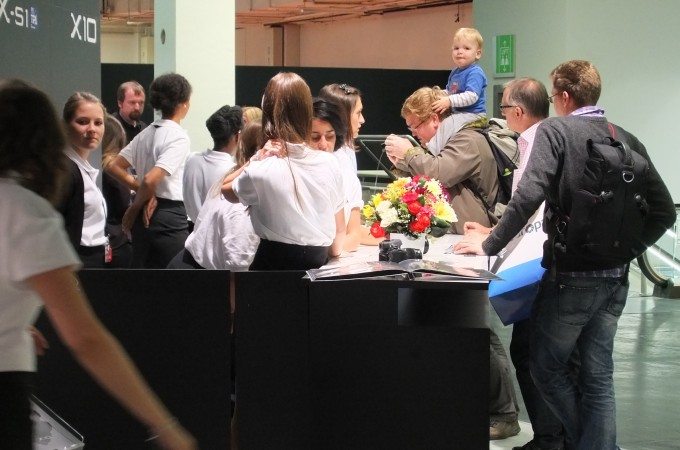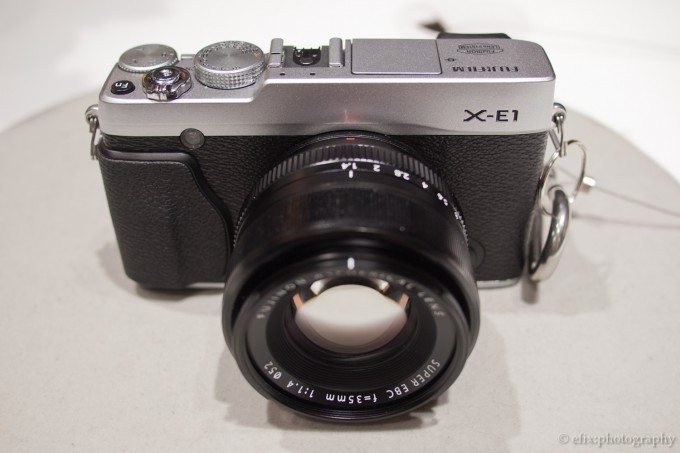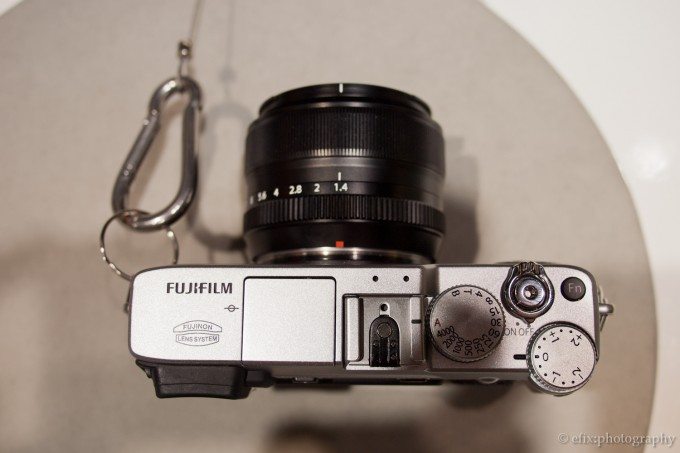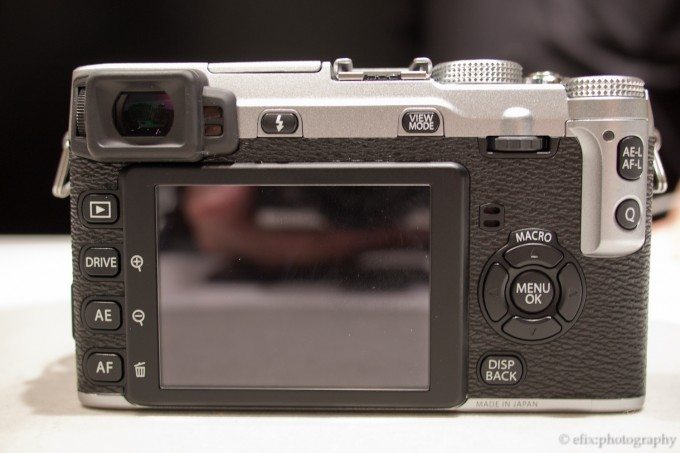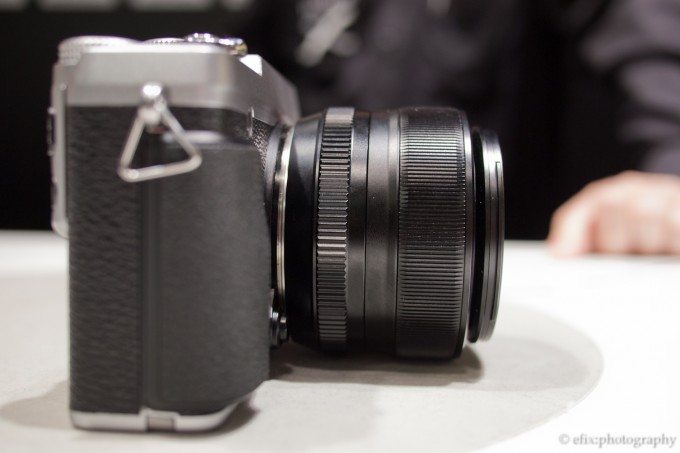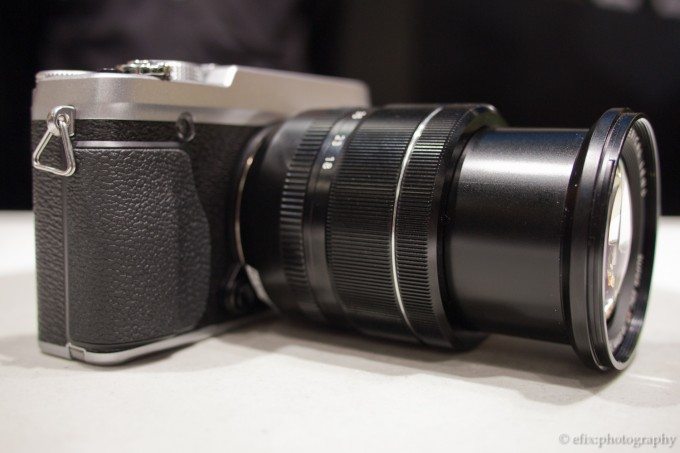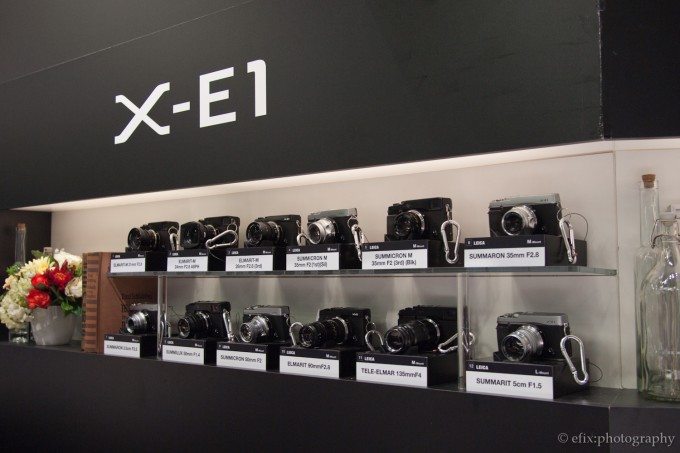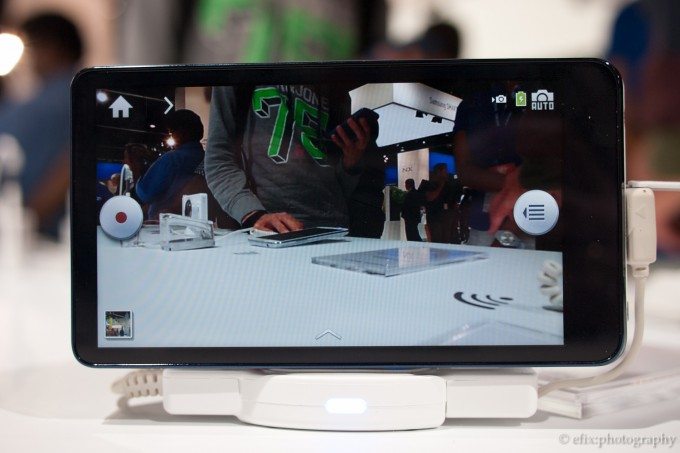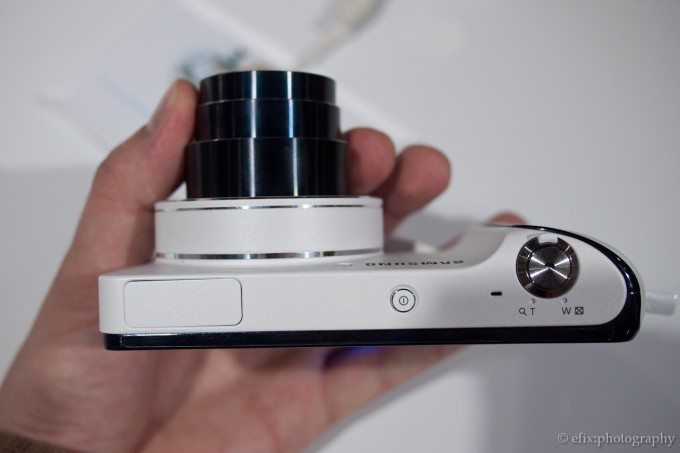Last Updated on 09/25/2012 by Felix Esser
The new Fujifilm XF1 retro compact comes with three distinctively colored leatherings.
As promised, here’s part two of our multi-part Photokina 2012 report. In today’s issue: the Fujifilm XF1 and X-E1, thoughts on the focusing speed of the new X series firmware with the X 35mm f1.4 lens, the new 18-55mm f2.8-4 X series lens and the Samsung Galaxy camera.
Fujifilm
Ahead of photokina 2012, Fujifilm announced two additions to their line of X series cameras, the XF1 and the X-E1. The former is a so-called enthusiast’s compact, sporting a fast lens and powerful sensor in a compact p&s body. The latter is a slimmed-down version of the X-Pro 1 without an optical viewfinder and a slightly smaller body. I spent a little hands-on time with both at the Fujifilm stand.
XF1 — The XF1 is Fujifilm’s first foray into the enthusiast’s compact niche. Sporting a fast f1.8 lens and a 2/3″ EXR CMOS sensor, the XF1 promises great image quality coupled with extraordinarily sexy retro looks (see our news announcement here). It’s available in three different colors, as can be seen in the title image above.
The XF1 in red with the pop-up flash popped up and the lens in standby position. Powered off, it retracts even further into the body and gives the camera an very slim profile.
The lens fully extended.
The XF1’s top, like the whole camera, is very minimalistic and features the pop-up flash, XF1 label, Fn button, shutter button and mode dial.
The rear of the XF1 is dominated by the screen. Operation wise, the XF1 has all you need, including two click wheels, one at the top and one around the menu button. The E-Fn button gives direct access to various settings that are displayed on the screen.
All in all, the XF1 is a very nice camera. Size-wise, it doesn’t give much to its contenders. The retractable lens is neat and works very well. Pull it out, and the camera goes into standby. Twist it a few degrees, and the camera is fully activated. Twist it back to “Standby” at any time to save power. Quite ingenious. Focus is snappy, and the overall image quality looks pretty solid from what I can tell from the JPEGs I took. In EXR mode using half resolution (which is how the EXR sensor should be used, in my honest opinion), even at 1600 ISO the quality seems fine for a compact. By the way, it’s the same sensor as in the X10. Below are a few snaps I took with it (one of the few cameras I was actually allowed to take pictures with.)
Close-up, shallow-ish depth-of-field with mild background blur is possible with the XF1.
ISO 1600 in EXR mode and the zoom fully extended. Click the image for a full-size version. The quality is not bad for a compact, but you can see some definitive loss of detail smearing resulting from the noise reduction. The sensor is the same as the one in the X10 (our review here.)
The Fujifilm XF1 can be pre-ordered at B&H photo in black, tan and red color.
X-E1 — This is the second camera to sport Fuji’s new X mount (first introduced with the X-Pro 1), and man is it one heck of a camera! (We posted the news on the X-E1 and the new X lenses here.) Not only does it look incredibly awesome, it’s also exactly the right size, being slightly smaller than the X-Pro 1, and feels absolutely superb in the hand. The viewfinder is AWESOME (it’s a new panel, not the same as in the X-Pro 1) and with the upgraded focusing algorithms, even the 35/1.4 focuses pretty quickly now. Even with the new firmware, though, the bottleneck remains the focusing mechanism which just isn’t built to focus ultra fast. I think the 35/1.4 with the new firmware focuses a bit quicker than my E-P1 with the Panasonic 20/1.7 (see in the video below and judge for yourself!) The 18-55 is also a nice lens that focuses very quickly. Sadly, the new 14mm wasn’t available yet.
The Fujifim X-E1 with the 35/1.4 lens attached. I think it looks absolutely gorgeous!
The layout of the controls is virtually identical with the X-Pro 1. Note that the X-E1 gained a pop-up flash.
The quality of the EVF is amazing. The grip at the front ant the protrusion at the top right where your thumb rests make holding the X-E1 very comfortable. The overall size-weight ratio is almost ideal — for me personally at least.
The 18-55mm zoom is larger than the other X lenses, especially when fully extended, but still acceptably small.
After holding the X-E1 in my hands and playing with it for a little while, I am drawn very much toward it. I was afraid the 35/1.4 would still be a slouch focus-speed-wise, but I can positively state it isn’t — although, again, it still isn’t super quick either. The X-E1 is a super fun camera and once the issues with RAW conversion of the X-Trans CMOS files is properly dealt with, I can’t guarantee I won’t give up Micro Four Thirds and invest in the X system. The potential is definitely there, and I think Fuji are on a good way to get rid of the initial teething troubles of the system.
Sadly, I was not allowed to take any pictures with the X-E1, as the firmware still wasn’t final. But the image quality should be identical to that of the X-Pro 1, considering they feature basically the same innards.
Awesomeness: a bunch of X-E1s with Leica M lenses attached. The lack of focus peaking is a downside, though, and makes the X-series cameras less attractive to users of legacy lenses.
The Fujifilm X-E1 can be pre-ordered at B&H Photo in silver and black. The 18-55mm lens can be pre-ordered as well, as can be the new 14mm lens.
Samsung
Samsung didn’t announce any overly exciting stuff. I’ve never been particularly blown away by their NX mirrorless system, and while the EX2F certainly is a great enthusiast’s camera, it’s been announced a while ago (see our news here) so it wasn’t really news. However, what I was curious about was the Galaxy Camera (announced here).
So, what makes the Galaxy Camera noteworthy? Well, besides featuring an approx. 20x zoom lens that goes from 23-481 mm (equivalent), it’s the fact that the camera runs on Android. Yes, the same stuff you have in your smartphone. And the screen is as large as that of a smartphone, too: 4.8″. Which is even a bit larger than most Android smartphones. While the sensor doesn’t impress much — it’s 1/2.3″ type with 16.3 megapixels –, the fact that the camera doubles as a full-fledged Android computer means that you can have all the same apps that you have on your smart phone — but with a real, proper compact camera at the rear end.
The perfect synthesis of smartphone and camera, then? Well, that remains to be seen once first reviews of the Galaxy Camera appear. The large touchscreen, which dominates the back of the camera, makes it not only very comfortable to frame, but also to operate it. Though direct access buttons are often a lot quicker, the question is how many p&s users actually need that. Every menu option is easily accessible on the Galaxy Camera, and the fact that you can quickly open your pictures in various editing and sharing apps should make this camera very interesting to a lot of casual, socially networking snappers.
For my own part, I found the overall size of the camera to be a bit too much on the bulky side, and this might in fact turn people off from buying it. A 4.8″ screen might be more comfortable to operate than a 4″ screen, but size wise, the latter would’ve been preferrable. But who knows, maybe Samsung will come up with a smaller version of the Galaxy Camera soon?
So much for part two of our Photokina 2012 report. Tomorrow: Olympus and Panasonic. Stay tuned!
Please Support The Phoblographer
We love to bring you guys the latest and greatest news and gear related stuff. However, we can’t keep doing that unless we have your continued support. If you would like to purchase any of the items mentioned, please do so by clicking our links first and then purchasing the items as we then get a small portion of the sale to help run the website.


